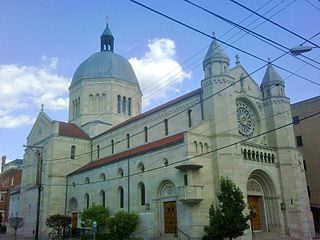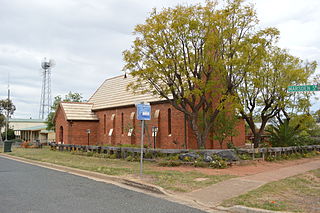
The Cathedral Church and Minor Basilica of the Immaculate Mother of God, Help of Christians is the cathedral church of the Roman Catholic Archdiocese of Sydney and the seat of the Archbishop of Sydney, currently Anthony Fisher OP. It should not be confused with the nearby, later, Anglican St Andrew's Cathedral. It is dedicated to the "Immaculate Mother of God, Help of Christians", Patroness of Australia and holds the title and dignity of a minor basilica, bestowed upon it by Pope Pius XI on 4 August 1932.

Taralga is a small village in the Southern Tablelands of New South Wales, Australia in Upper Lachlan Shire. It is located at the intersection of the Goulburn-Oberon Road and the Laggan-Taralga Road. It is accessible from Oberon to the north, Mittagong to the east, Goulburn to the south, and Crookwell to the west. At the 2016 census, Taralga had a population of 467. Taralga is located relatively close to the famous Wombeyan Caves. The town experiences a volatile climate and is frequently affected by snow in the winter months.

The Basilica-Cathedral of St. John the Baptist in St. John's, Newfoundland and Labrador is the metropolitan cathedral of the Roman Catholic Archdiocese of St. John's, Newfoundland and the mother church and symbol of Roman Catholicism in Newfoundland.

Christ Church St Laurence is an Anglican church located at 814 George Street, near Central railway station and Haymarket, in Sydney, New South Wales, Australia. It is the principal centre of Anglo-Catholic worship in the city and Diocese of Sydney, where the Anglican church is predominantly Evangelical in character. Anglo-Catholicism is manifested at Christ Church St Laurence by an emphasis on the sacraments, ritual, music and social action, all of which have been prominent features of Anglo-Catholicism since the 19th century.

The St Saviour's Cathedral is the heritage-listed cathedral church of the Anglican Diocese of Canberra and Goulburn in Goulburn, Goulburn Mulwaree Council, New South Wales, Australia. The cathedral is dedicated to Jesus, in his title of Saviour. The current dean is the Very Reverend Phillip Saunders. It was added to the New South Wales State Heritage Register on 20 April 2009.

The Cathedral of Saint Joseph of Wheeling or Saint Joseph's Cathedral is the seat of the bishop of the Catholic Diocese of Wheeling-Charleston. In addition to being the seat of the bishop, the cathedral is home to the oldest congregation in the city of Wheeling, West Virginia. The cathedral is a contributing property to the East Wheeling Historic District on the National Register of Historic Places.

St. John the Evangelist is a historic Roman Catholic Church at 2270 Massachusetts Avenue in Cambridge, Massachusetts.

Saint Joseph's Roman Catholic Church is a historic Roman Catholic church building in Mobile, Alabama, United States. It serves as the parish church for St. Joseph's Parish in the Roman Catholic Archdiocese of Mobile.

St Mary Star of the Sea is a historically significant Catholic parish church in West Melbourne, Victoria, Australia. The foundation stone of the church was laid in 1882 and the building was completed by 1900. Since 2002, restoration has been ongoing to restore the church to its original state. Built with seating for over 1,200 people, it has been described as the largest parish church in Melbourne, in Victoria, or even in Australia.

St Martin's Cathedral is a cathedral in Slovakia. It is located in the town of Spišská Kapitula and is the cathedral church of the Spiš diocese.

Christ Church Cathedral is a heritage-listed Anglican cathedral complex at Duke Street, Grafton, Clarence Valley Council, New South Wales, Australia. The cathedral was designed by John Horbury Hunt and built from 1874 to 1884 by Reynold Brothers (brickwork) and G. J. T. Lawson (woodwork). It is also known as Cathedral Church of Christ the King and Grafton Anglican Cathedral. The property is owned by the Anglican Diocese of Grafton. It was added to the New South Wales State Heritage Register on 14 March 2003.

English Martyrs' Church is in St George's Road, Wallasey, Wirral, Merseyside, England. It is an active Roman Catholic church in the diocese of Shrewsbury. The church is recorded in the National Heritage List for England as a designated Grade II* listed building.

St Patrick's Church is a heritage-listed Roman Catholic church at Rosewood - Aratula Road, Rosevale, Scenic Rim Region, Queensland, Australia. It was designed by Father Andrew Horan and built from 1888 to 1889. It was added to the Queensland Heritage Register on 11 December 2009.

The Roman Catholic Church of Saint Ignatius Loyola is a heritage-listed church at 46 Grove Street, Toowong, City of Brisbane, Queensland, Australia. It was designed by architect John Francis Hennessy, junior, and built from 1929 to 1936 by Concrete Construction (QLD) Limited. It was added to the Queensland Heritage Register on 12 July 2005.

St Mary's Catholic Church is a heritage-listed Roman Catholic church at 20 Merivale Street, South Brisbane, Queensland, Australia. It was designed by Simkin & Ibler and built from 1892 to 1929. It was added to the Queensland Heritage Register on 3 December 2004.

Christ Church Anglican Church is a heritage-listed Anglican church at King Street, Bungonia, Goulburn Mulwaree Council, New South Wales, Australia. The current church was designed by William Kemp and built from 1877. The church is administered by St Nicholas Anglican Church, North Goulburn. It was added to the New South Wales State Heritage Register on 1 October 1999.

St Peter and Paul's Old Cathedral is a heritage-listed former Catholic cathedral and now parish church at 42 Verner Street, Goulburn, Goulburn Mulwaree Council, New South Wales, Australia. It was designed by Andrea Stombuco and Charles Spadacini and built from 1871 to 1890 by C. J. O'Brien and Wilkie Bros. It is also known as St. Peter and Paul's Former Cathedral and St Peter and Paul's Catholic Cathedral; Saints Peter and Paul's Catholic Cathedral. It was added to the New South Wales State Heritage Register on 20 April 2009.

St Anne's Church is a heritage-listed Roman Catholic church located at 60 Blair Street, North Bondi, Waverley Municipality, New South Wales, Australia. The church was designed by Joseph Fowell and Kenneth McConnel, and built from 1934 to 1964 by R. M. Bowcock. It is also known as St. Anne's Church and St Anne's Shrine. The property is owned by The Sisters of Mercy and it was added to the New South Wales State Heritage Register on 26 May 2006.

The All Saints' Anglican Church is a heritage-listed Anglican church located at McDonnell Street, Condobolin in the Lachlan Shire local government area of New South Wales, Australia. The church was possibly designed by Edmund Blacket and was built from 1878 to 1879 by Mr Brinsmead. It is also known as All Saints Anglican Parish Church. The property is owned by the Anglican Diocese of Bathurst. It was added to the New South Wales State Heritage Register on 2 May 2008.

The Trinity Uniting Church is a heritage-listed Uniting church located at 62 The Boulevarde, in the Sydney suburb of Strathfield in the Municipality of Burwood local government area of New South Wales, Australia. It was designed by George Sydney Jones & Harry Thompson and built from 1889 to 1890 by Thomas Hanley of Balmain. It is also known as Trinity Congregational Church. The property is owned by the Uniting Church in Australia. It was added to the New South Wales State Heritage Register on 19 September 2003.





















